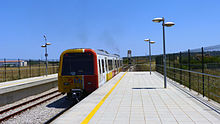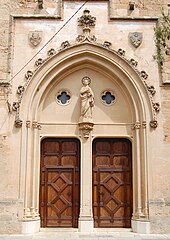Petra (Mallorca)
| Petra municipality | ||
|---|---|---|
| coat of arms | Map of Spain | |

|
|
|
| Basic data | ||
| Autonomous Community : | Balearic Islands | |
| Island: | Mallorca | |
| Comarca : | Plà de Mallorca | |
| Coordinates | 39 ° 37 ' N , 3 ° 7' E | |
| Height : | 111 msnm | |
| Area : | 70.13 km² | |
| Residents : | 2,860 (Jan 1, 2019) | |
| Population density : | 40.78 inhabitants / km² | |
| Postal code : | 07520 | |
| Municipality number ( INE ): | 07041 | |
| Nearest airport : | Palma ( Son Sant Joan / Palma de Mallorca , 34 km ) | |
| administration | ||
| Official language : | Catalan , Castilian | |
| Mayor : | Salvador Femenías ( PI ) | |
| Address of the municipal administration: | C / Font, 1 07520 Petra |
|
| Website : | www.ajpetra.net | |
| Location of the municipality | ||
Mallorca
|
||
Petra is a small country town and administrative center of the homonymous municipality on the Balearic -Insel Mallorca . The streets running at right angles are lined with old houses made of golden-brown quarry stone ( Marès ). All in all, Petra looks sleepy and far from any hustle and bustle. The grapes for a famous very good wine grow in the area.
The municipality of Petra covers an area of 70.13 km² and borders the municipalities of Manacor, Vilafranca de Bonany , Sineu , Ariany and the northernmost narrow extension of the area extends past Santa Margalida to Artà . On January 1, 2019, the community had 2860 inhabitants, the capital of the same name 2574 inhabitants (as of 2008). In 2006 the proportion of foreigners in the municipality was 9.8% (269), the proportion of German residents 1.9% (52).
geography
location
The municipality is located around 44 kilometers from Palma on the main road MA-3320 from Manacor in the direction of Inca in the landscape area of the Pla.
climate
In Petra, rainfall is recorded throughout the year. The driest month is July with an average of 8.8 l / m². The highest amount of precipitation is recorded in October with an average of 101.3 l / m².
history
The Arabs, who founded the small town in the interior of the island, named it after its big Jordanian sister "The Radiant". In Moorish times, Petra belonged to the Juz or Yiynaw-Bitra district. This district fell to King James I after it was conquered by the Catalans.
In the years 1949 and 1952 the first attempts to split off from Ariany were made, in 1982 Petra was separated and became an independent community.
In the municipality there are around 40 archaeological sites from different historical epochs that have been cataloged. The caves of Ses Cabanasses , Ses Comunes Noves and Son Monserrat , as well as the Talaiot settlements of Son Homar , Termenor and Es Castellots , the Son Maimó grave caves and the remains of Bosc Vell , Es Cabanells Nous and Sa Font are particularly noteworthy . During excavations, remarkable finds from Roman times such as amphorae, various ceramic objects and funerary urns have been found.
economy
Today, after the railway - albeit on a new route around the town - is back in operation, the place mainly attracts tourist groups who want to visit the birthplace and the associated museum of the city's most famous son, Junípero Serra . In contrast to the widely traveled Franciscan priest, his world-forgotten hometown was not exactly blessed with luck.
Beginning
Attempts by some families to give Petra economic importance through viticulture failed in the 1920s due to the boom in Spanish mainland wines from Navarre , Rioja and Penedès . And this episode of a small economic success can only be reported with a somewhat sad but typical ending for the Pla landscape.
today
After this area was recognized as a wine-growing area in 1993, business activity in this sector was considerably expanded throughout the area (planting new vines, introducing new grape varieties, improving cultivation techniques, etc.). At the same time, the number of wineries also increased. Significant investments in new technologies have also been made in the existing companies, which has led to an increase in production and, in particular, an improvement in the quality of the wines produced here.
There are wines again with designations of origin of recognized quality. The red wines are made from the following red grape varieties: Callet, Fogoneu, Tempranillo , Manto Negro, Monastrell, Cabernet Sauvignon , Merlot and Syrah . White wines are made from the Chardonnay , Moll , Macabeo, Parellada and Moscatel varieties .
The ground consists of calcareous rock (marl and dolomite), as a result of which a calcareous and clayey soil with a slightly alkaline pH value has formed and the earth has tints that range from the red scale to almost white.
These properties of the soil lead to good drainage, which also leads to rapid rooting of the soil due to the only minimal amount of organic matter, which means that viticulture can be carried out under very good conditions.
Personalities
Petra is particularly known as the birthplace of the famous missionary Junípero Serra , the founder of San Francisco (USA) and other well-known places such as San Diego (USA) . He was born as Miquel Josep Serra i Ferrer in Petra in 1713. In 1749 he traveled to Mexico and worked as a missionary for two decades. He was beatified by Pope John Paul II in 1988 and canonized by Pope Francis on September 23, 2015. His bust stands in the Capitol in Washington DC , along with the busts of other famous figures from the United States of America
Attractions
- Parish church of San Pere , large open arcades and a huge rose window decorate this church. In the arcade area there is a monument in honor of the Mallourcan farmer's wife.
- Santuari de la Mare de Déu de Bonany monastery , a few kilometers outside of Petra to the west
- Convent de Sant Bernardí from 1677.
- Molins de vent One of the 19 flour windmills on the Balearic island of Mallorca.
- The birthplace of the famous missionary Serras and a museum in his honor. On the Placa Padre Serra there is a monument with tile pictures on his life story.
Wayside crosses
- Creu des Còdols built in 1892, on the Plaça de sa Creu square
- Creu des Vall built in 1891 on Carrer Ciutat street
- Creu des Cementiri is located on Plaça del Pare Serra, built in 1820
Museums
- Museu Juniper Serra - this museum was established in 1959 by a group of Amics de Fra Juníper Serra . Located on the streets: Carrer Barracar / Fray Juniper Serra, there is a sign on the door where you can pick up the key to the museum. In the small museum there are mementos of the Franciscan Father Fray Junipero Serra, who was born in Petra on November 24th, 1713 .
Festivals
- Santa Praxedes (July 21).
- Festa dels Angels (2nd / 3rd Aug).
- Festa de Beat Juniper Serra , on the third Sunday of September, procession of decorated floats in honor of the blessed missionary. Fray Junípero Serra founded 21 mission stations in what is now California in the mid-18th century. From these stations, metropolises like San Francisco, San Diego or Monterey emerged.
Markets
- Weekly market takes place every Wednesday in Plaça Ramon Llull .
Individual evidence
- ↑ Cifras oficiales de población resultantes de la revisión del Padrón municipal a 1 de enero . Population statistics from the Instituto Nacional de Estadística (population update).





